High Peaks Pure Earth has translated a blogpost by Woeser written on September 28, 2011 for the Tibetan service of Radio Free Asia andposted on her blog on October 5, 2011.
This series of posts covers Woeser’s summer travels to Amdo, Kham and Lhasa and follows on from the last post “The Kardze Pledge”. Woeser goes deep into the modern history of Kham in this post, focusing on the 1930s and the figure of Geta Rinpoche (or Getag Tulku), a reincarnated Lama who was one of the early Tibetan Communists.
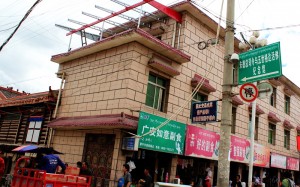
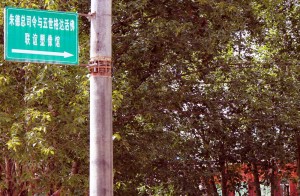
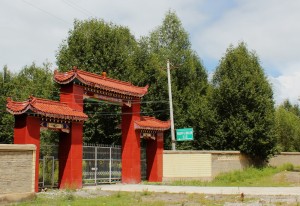
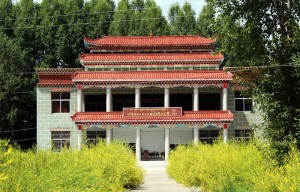
I took the above photos when passing through Kardze in July 2011
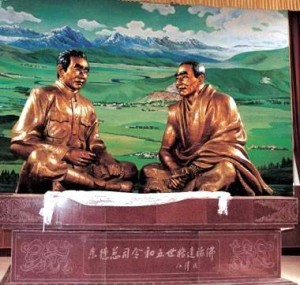
“The Used Geta Rinpoche”
By Woeser
After we arrived in Kardze at the end of July, I suddenly noticed a street sign attached to an electricity pole at the side of the road, which read: “Memorial Hall for the Commander in Chief, Zhu De and the 5th Geta Rinpoche”. Had this been built in recent years? I followed the sign, was slowly guided out of the city and finally found a tightly closed red door with a Chinese-style building behind it and verdant trees and lush flowers surrounding it; the hall name was an eye-grabbing piece of calligraphy created by Jiang Zemin.
Afterwards I found on the internet that the construction of this hall began in 1991 and was completed in 1993, becoming the “base for patriotic education” from Kardze County and Prefecture all the way to Sichuan Province. According to the introduction, “the hall features the detailed descriptions of the 5th Tulku’s entire life, accounts of how the Red Army passed through Kardze during the Long March as well as revolutionary relics”. I noticed that among them were “paintings and photos of the establishment of the first ethnic minority region during the Soviet Tibetan Bopa Government; and also images of Geta Rinpoche, the Vice President of the Bopa Government and its other Tibetan members”.
How did the name of “Bopa Government” come about? It is quite a complicated story, just as the Communist Party admits, on its Long March, the Red Army established two “Republics”, namely the Gyarong Republic and the Bopa People’s Republic. These regimes were all established on Tibetan territory, the former where today’s Gyarong area of Rongdrak county is located and the latter in today’s Kham Region (Kardze and other counties); their declarations did by no means go against the native population’s political and religious authority, instead they determined the following: “all Tibetan territory will always be administered by the regional Bopa Government. We swear to oppose Han Chinese aggressors, KMT officials and warlords that have put in place politics of annexation for thousands of years and we firmly stand for the course of liberating and making an independent Bopa”; “Our flag is one of an independent Bopa, our current mission is to revive Tibet and extinguish Chiang Kai-shek.”
Let us look back at what happened more than 70 years ago, relevant comments conclude that the Communist Party’s minority policies did initially support “self-determination” and even “independence”, but today are against “ethnic splittism”. However, for the fleeing Red Army, their so-called assistance to establish a “Bopa Government”, at the time, was in fact only an expedient and temporary measure and was by no means a “‘solemn commitment’ to the Tibetan people”. In actual fact, during its 12,500 km Long March, regardless of whether they passed by Chinese, Tibetan, or other minority areas, from the facts that have been revealed today, we know that the Red Army’s journey was one of empty promises and swindle.
The Tibetans had to pay for the assistance to “revive Tibet and extinguish Chiang Kai-shek” and to establish an independent political entity. According to Party documents, during the 16 months before and after the Red Army passed through Ngaba Prefecture, the Gyarong Government had to provide 5 million kilos of staple foods as well as 100,000 cows, sheep, horses, pigs and other livestock; when the Red Army passed through the northern Kham region, the Bopa Government had to provide 2.25 million kilos of staple foods. After the Red Army had firmly settled in Yan’an, Mao Zedong said to the American journalist Edgar Snow: “the Red Army’s only external debt is that it took away the food from the outer ethnic minorities and now owes them, one day, we must repay this debt.” But what does this “external debt” mean? Does this not refer to owing a foreign country? It shows that at the time, Mao Zedong did not consider Tibet a part of China.
As for Geta Rinpoche of Beri Monastery in Kardze County, together with other Tibetan elite such as Jago Tobdan, Pangta Tobgyel, Gompo Tsering, Tashi Wangchuk, he formed the leadership of the Bopa Government and they jointly formulated a programme that included the guiding principles, including “ethnic independence, the establishment of an independent Bopa Soviet Government, and its own Bopa territory” as well as “the unification of the red Army and all groups and individuals that support the independence of Bopa”; they firmly believed that “all the people, countries, governments and armies that support and sympathise with Bopa are also Bopa people’s friends”; however, in the end, they were ridiculed by historical events for exactly this naivety.
If we want to justly evaluate historical figures such as Geta Rinpoche, we must admit that essentially, they were all Tibetan nationalists rather than repeatedly used by the Communists; he pursued the title of the “Red Tulku” of the “unified ancestral land”. Some people say that if Geta Rinpoche had lived until the Red Army became the Liberation Army, he would probably sooner or later have been thrown into prison, just as it happened to Phuntsog Wangyal. But just as the Liberation Army launched its “Chamdo military campaign”, he suddenly died a violent death, and thus became the justification for why the Communists violated or forgot their “solemn commitment”.
September 28, 2011, Lhasa

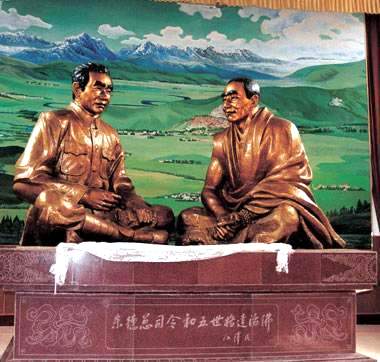


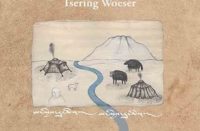
Pingback: “The Used Geta Rinpoche” By Woeser « Tibetan Blog Station
Pingback: “Nyarong County’s Gonpo Namgyal” By Woeser